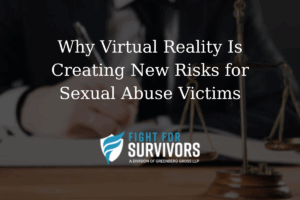
The rise of virtual reality has introduced an entirely new dimension of social interaction—and with it, a new frontier of harm. For survivors of sexual abuse, the immersive nature of virtual spaces is not only triggering, but potentially retraumatizing in ways we are only beginning to understand. As virtual reality platforms evolve faster than policy or regulation can keep up, sexual harassment, sexual assault, and exploitation are increasingly making their way from the physical world into digital environments.
This shift creates significant risk—especially for young people, survivors of past trauma, and those navigating virtual spaces without the protections typically expected in real-world settings. While virtual reality can be a powerful tool for communication and learning, it’s also giving rise to a disturbing trend: the replication of abuse in digital spaces that can feel just as real, without the same legal safeguards or reporting systems.

A Wake-Up Call in the Virtual World
Contact Us For A Free Legal Consultation. No Fee.
Call (833) 55-FIGHTEmerging technologies, including augmented reality, virtual reality, and mixed reality, are rapidly redefining how people interact online. Yet with every technological leap comes a set of emerging risks, particularly when it comes to interpersonal violence. The immersive experience of VR can blur the lines between reality and simulation—making acts of sexual abuse, harassment, or assault in these environments more psychologically harmful than many might assume.
Several studies and key findings have shown that users—especially young adults and sexual assault survivors—report feelings of helplessness, fear, and post-traumatic stress disorder symptoms after being violated in a virtual space. The virtual nature of these acts does not diminish their emotional impact; in fact, it can amplify them due to the intimate, close-range interactions made possible through virtual avatars and proximity simulation.
The Rise of Virtual Sexual Violence
Sexual violence in virtual reality includes a wide range of behaviors that mirror abuse in the physical world: unwanted touching of avatars, verbal harassment, simulated sexual assault, and even coerced sexual acts through VR headsets. Known as virtual sexual violence or even virtual rape, these offenses often occur in multiplayer games, social VR platforms, and private networks that lack moderation or oversight.
Unlike physical environments where victims might flee or call for help, virtual environments often lack functioning reporting systems, user protections, or immediate moderation. Survivors may experience distress without any realistic way to address abuse in the moment. This lack of accountability and safety makes VR spaces a breeding ground for repeat offenders—and puts victims at even greater risk.
Children and Emerging Harms
Child sexual abuse and exploitation are also taking new forms in VR. Reports have surfaced of child sexual abuse material being recreated using avatars, as well as grooming behaviors occurring in platforms used by children and teens. Because many of these platforms are not subject to strict child safety online policy, they become highly vulnerable to abuse and exploitation.
The online safety bill in the UK, along with efforts by other UK regulatory bodies and the European Union, is beginning to confront these issues. However, enforcement and technological adaptation are slow. This leaves many minors exposed to emerging risks from strangers or even adults pretending to be children in VR.
As children spend more time in immersive technology spaces, the future risks children face grow exponentially. Preventing sexual violence in VR must become a central part of global child safeguarding policy. The lack of clearly defined boundaries in the virtual world means new and emerging technology is advancing faster than our ability to protect its youngest users.
How VR Re-Traumatizes Survivors
For survivors of sexual assault and sexual abuse, virtual violations can trigger old wounds. While these acts may not involve physical touch, the psychological impact is real—especially when avatars simulate unwanted behavior or verbal abuse. Survivors may experience flashbacks, panic attacks, or suicidal tendencies following such interactions, especially if they have not fully healed from past trauma.
Virtual reality also enables perpetrators to operate without consequence. The anonymity of digital avatars allows individuals to engage in criminal behaviour with limited risk of exposure or accountability. For survivors, this creates a chilling environment where abuse can happen repeatedly, with no sense of safety or recourse.
This issue is even more complex for young people, who may not yet understand how to identify or report abuse in virtual environments. Their developing brains are still forming the prefrontal cortex—responsible for judgment, reasoning, and risk assessment—which makes them particularly vulnerable to aggressive behavior, coercion, and exploitation online.
Addressing Abuse in Virtual Spaces
The responsibility to prevent abuse in VR doesn’t rest solely with survivors or users—it must be owned by technology companies, developers, regulators, and law enforcement agencies. There is an urgent need to develop clear guidance, ethical considerations, and prevention programs tailored to virtual spaces.
Recommendations include:
- Enforcing real-time moderation in VR environments
- Building in panic buttons or instant-report features
- Limiting proximity access between avatars by default
- Banning known offenders from platforms with child or public access
- Integrating robust content filters to prevent child sexual abuse material from circulating
- Ensuring the online safety regime includes immersive technologies like VR and AR
- Providing mental health support for users exposed to abuse
- Including child safeguarding specialists in technology policy planning
The Role of Law Enforcement and Regulation
Law enforcement agencies are only beginning to grapple with how to investigate and prosecute crimes that occur in virtual environments. Many officers lack training on how virtual sexual violence and online sexual harassment work—or how these experiences affect survivors.
Efforts to support survivors must include:
- Training officers to recognize abuse in digital spaces
- Creating better cross-jurisdiction collaboration between cybercrime units
- Updating laws to reflect emerging technology forms and their potential for harm
- Working with uk regulatory bodies and international partners to standardize virtual safety laws
Moreover, technology industry leaders must be held accountable for how they design platforms. A safe environment is not a feature—it’s a fundamental right, especially in spaces that host young people or simulate real-world interactions.

Virtual Reality, Real-World Consequences
The notion that “it’s just virtual” fails to account for the lived experiences of abuse survivors in these digital settings. VR technology has created a significant risk for many individuals, and that risk is increasing as platforms become more immersive, personal, and emotionally triggering.
The mental health consequences are real. For victims, experiencing assault—even virtually—can result in depression, anxiety, avoidance behaviors, and loss of trust in digital environments. Those who already have a history of trauma may find themselves reliving their abuse in shocking, high-fidelity scenarios.
The existing and emerging risks within the virtual world are not hypothetical—they are present now, and they are already harming people. Waiting for more national statistics to confirm what survivors are already experiencing does nothing to protect them.
Survivors Deserve Protection—Online and Off
No survivor should be forced to relive trauma—especially in spaces designed for connection, fun, or learning. Whether the abuse happens in the physical world or in VR, it matters. Survivors deserve justice, support, and safe digital environments where they can heal, not be retraumatized.
If you or someone you know has been harmed in a virtual space, there are resources and professionals who understand and can help. Reporting abuse in digital platforms may seem new and complicated, but survivors should never be left behind by the pace of emerging technologies.
We must protect the most vulnerable, demand ethical innovation, and create virtual environments that prioritize safety, accountability, and healing.
Frequently Asked Questions
Can abuse in VR really affect mental health the same way as physical abuse?
Yes. Survivors have reported trauma symptoms, including anxiety, PTSD, and dissociation after virtual violations—especially when these mirror real-life past abuse.
Are there laws against sexual abuse in virtual spaces?
Laws are still evolving. Some countries are working to include VR-specific protections in their online safety bill and digital policy, but enforcement is inconsistent.
How can children be protected in VR?
By enforcing child safety online policy, requiring real-time moderation, and creating stricter age-gating. Education and prevention programs must also reach parents, educators, and young users.
What should I do if I witness abuse in VR?
Use platform-specific reporting systems immediately. Save any evidence, and contact legal or advocacy groups if the abuse involves minors or rises to criminal behavior.
How can we make VR safer?
Through collaboration between technology companies, policymakers, law enforcement, and survivor-led organizations. The goal is to address abuse before it occurs and deliver long-overdue protections.
Experienced Attorneys Who Will Listen And Fight For You
Speak To An Attorney Now »